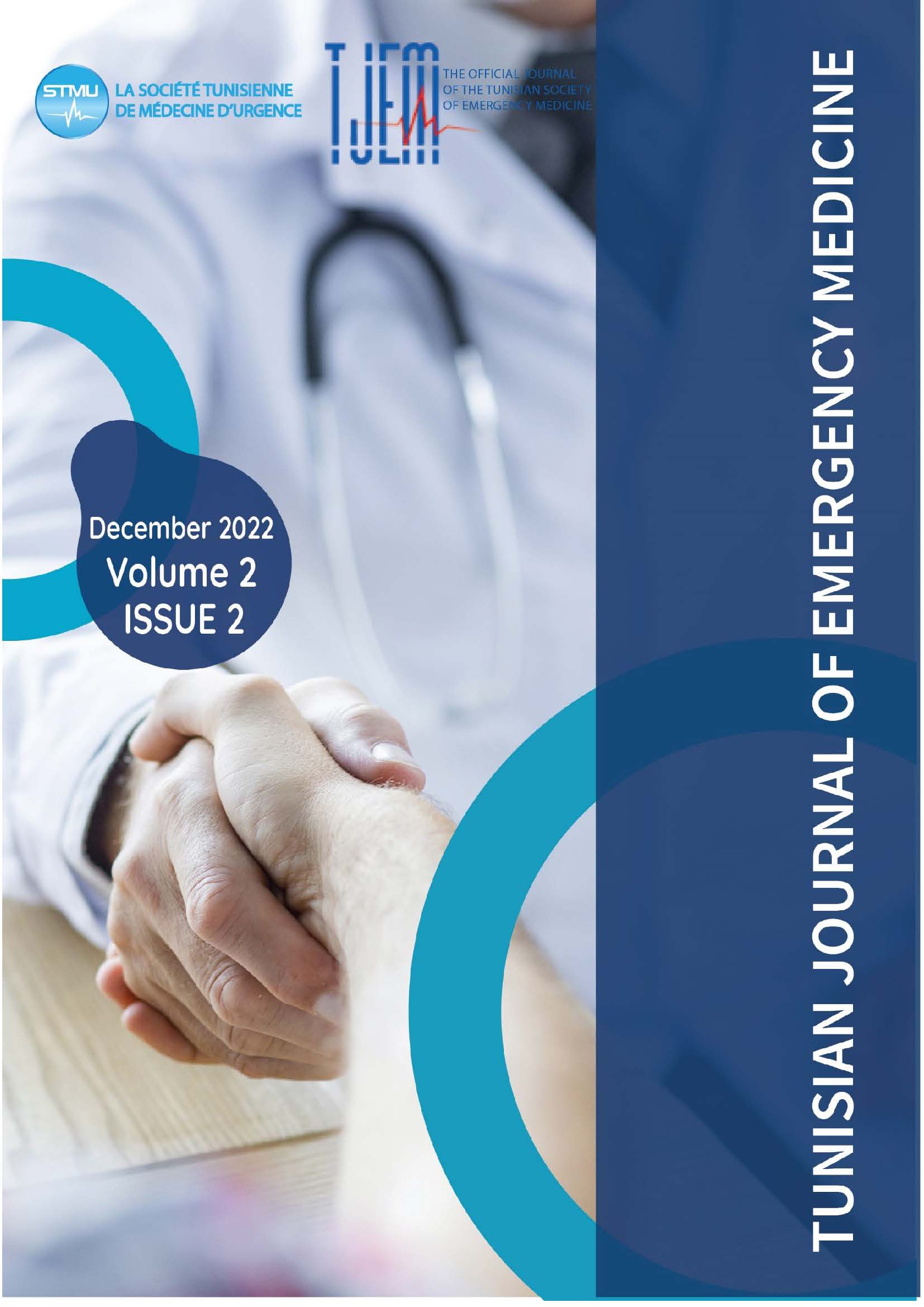Prognostic factors of assault-induced stab wounds in the emergency department
Safia OTHMANI, Sarra JOUINI, Asma MELLOULI, Houyem ZOUARI, Mouna JEMAI, Hana HEDHLI
DOI:
https://doi.org/10.0000/qabsd008Keywords:
Trauma, Stab wounds, Blood pressure, Respiratory rate, prognosisAbstract
Background: Stab wounds (SWs) represent one of the major components of trauma, especially in the emergency department (ED), and can have dreadful outcomes.
Aim: Our study aimed to assess the different epidemiological, clinical, and therapeutic features of SWs in the ED as well as prognostic factors determining short-term evolution (STE).
Method: A descriptive, cross-sectional single-center study was conducted in a polyvalent ED room of the Charles Nicolle hospital of Tunis, including patients presenting for assault-induced over ten months.
Unfavorable STE was defined by: oxygen therapy needs, fluid expansion, catecholamine and/or tranexamic acid use, transfusion, thoracic drainage, intubation, and urgent surgery.
The statistical analysis concerned the study population (SP) subgroups who have penetrating stab wounds (PSWs) or superficial stab wounds (SSWs). The risk factors search of STE was carried out by a univariate analysis, binary logistic regression with Receiver Operating Characteristics curves (ROC) analysis.
Results: We included 130 patients, with male predominance and a sex ratio of 15. The median age was 30. The majority (90.8%) had no pathological medical history. Forty percent of the injuries were located on the torso (n=52). Initial clinical assessment showed that most of the patients were hemodynamically stable Four patients (3.1%) had systolic blood pr tients (6.2%) a mean arterial blood pressure (MAP) <65mmHg. Seven patients (5.4%) were hypoxemic. Univariate analysis showed that respiratory rate (RR), and blood pressure (BP) were significantly associated with unfavorable STE. Receiving operating curve (ROC) analysis concluded a high discriminating ability for RR and BP. Logistic regression analysis showed that RR>19cpm and SBP <105 mmHg are independent risk factors with respective AORs of 8.64 and 14.29 IC.
Conclusion: Unfavorable STE can be predicted through clinical parameters such as RR>19cpm and/or SBP<105 mmHg in PSW's victims.
Downloads
Published
Issue
Section
License
Copyright (c) 2022 Tunisian Journal of Emergency Medicine

This work is licensed under a Creative Commons Attribution-NonCommercial-ShareAlike 4.0 International License.
How to Cite
Similar Articles
- Faten DHOUIB, Aimen Dammak, Faiza Safi, Fatma MHIRI, zied CHAARI, Successful Conservative Management of Penetrating Cervical Tracheal Injury: A Case Report , Tunisian Journal of Emergency Medicine: Vol. 3 No. 1 (2025): TJEM 2025: Vol.3 Issue 1
- Rim Karray, Kais Ben Jeddou, Hana Ksentini, Leila Chaari, Adel Chaari, Noureddine Rekik, The Perthes syndrome: a case report , Tunisian Journal of Emergency Medicine: Vol. 3 No. 1 (2025): TJEM 2025: Vol.3 Issue 1
- Houda Ben Soltane, ons haddaji, asma ammar, mariem khrouf, fatma Kacem, cyrine Zegdane, yosra Hasni, zied mezgar, Diabetes mellitus as an independent predictor of COVID-19 outcomes , Tunisian Journal of Emergency Medicine: Vol. 3 No. 2 (2025): TJEM 2025: Vol.3 Issue 2
- mahmoud ladhar, Chourouk Frikha, Manel Feki, Mouna Loukil, Faiza Safi, Mortality in Pediatric Intensive Care , Tunisian Journal of Emergency Medicine: Vol. 3 No. 2 (2025): TJEM 2025: Vol.3 Issue 2
- Sarra Akkari , Emna Rachdi , Jalila Ben Khlil , Prognosis in COVID-19: Impact of Pre-hospital Emergency Care , Tunisian Journal of Emergency Medicine: Vol. 2 No. 4 (2024): TJEM Vol2 Issue4
- Lassaad CHTOUROU, Jejunal Diverticulosis: Review , Tunisian Journal of Emergency Medicine: Vol. 2 No. 4 (2024): TJEM Vol2 Issue4
- Sondes laajimi, haifa bradai, Nabil Chebbi, Dorra Loghmari , imen EL KISSI, Naoufel Chebili , rabeb Mbarek, Specific Features of Chest Pain in Young People treated in Prehospital Care , Tunisian Journal of Emergency Medicine: Vol. 3 No. 1 (2025): TJEM 2025: Vol.3 Issue 1
- safia othmani, Ischemic acute cholecystitis: a case report , Tunisian Journal of Emergency Medicine: Vol. 2 No. 4 (2024): TJEM Vol2 Issue4
- Neila MAAROUFI, Firas Kessentini, Sabra Ouaz, Meriem Jemili, Moufida Nouari, Jihen Lakhal, Bilateral ptosis caused by midbrain hemorrhage: a case report , Tunisian Journal of Emergency Medicine: Vol. 3 No. 1 (2025): TJEM 2025: Vol.3 Issue 1
- Amira Sghaier, Marwa Toumia, Khaoula Bel Haj Ali, Adel Sekma, Kaouthar Beltaief, Zied Mezgar, Wahid Bouida, Riadh Boukef, Jamel Saad, Hamdi Boubaker, Mohamed Amine Msolli, Mohamed Habib Grissa, Semir Nouira, B-lines Ultrasonography Assessment by Nurses for the Diagnosis of Heart Failure in the Emergency Department , Tunisian Journal of Emergency Medicine: Vol. 2 No. 4 (2024): TJEM Vol2 Issue4
You may also start an advanced similarity search for this article.
Most read articles by the same author(s)
- safia othmani, Ischemic acute cholecystitis: a case report , Tunisian Journal of Emergency Medicine: Vol. 2 No. 4 (2024): TJEM Vol2 Issue4

